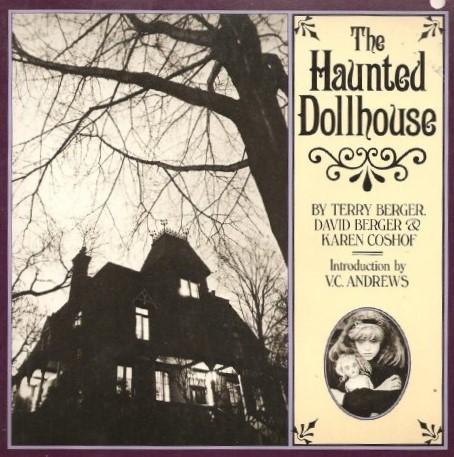 By TERRY BERGER, DAVID BERGER, KAREN COSHOF (Workman Publishing; 1982)
By TERRY BERGER, DAVID BERGER, KAREN COSHOF (Workman Publishing; 1982)
This kiddie picture book is more ambitious than most. It’s a lengthy (by traditional children’s book standards) depiction of a young girl’s immersion in a haunted dollhouse, related entirely through black and white photographic stills and short blocks of text. Introduced by the late V.C. Andrews (who proclaims the book a “monotone twilight zone that immediately evoked memories of my own childhood”), it’s far too tame and uneventful for my jaded tastes, but weaves an eerie spell.
The girl in question is the perky blond Sarah (portrayed by Nancy Massé), who on her thirteenth birthday makes the same wish she does on every birthday—with the text informing us that “This year her wish will come true. Perhaps it would be better if it hadn’t.” We’re not made privy to the particulars of that wish, but it evidently involves a dollhouse, an opulent example of which appears gift wrapped in her room that night. The next morning Sarah awakens to find herself inside said dollhouse. Here, dressed all in black (and with eyeshadow to match), she wanders with a doll in hand through this quasi-Victorian psycho-scape, where mirrors don’t cast reflections and water doesn’t act as it should, in search of her missing companions George, Mrs. Proudy and Thelma.
The brilliance of this book is in the artfully composed sepia toned photography, and the way it subtly diverges from the text. In an outdoor croquet scene, for instance, an “odd shaped ball” is mentioned that in the accompanying photo is revealed to be a skull, while a “strange statue” specified by a later passage is revealed as a reclining Virgin Mary.
A shot of the dollhouse at dusk, shrouded in darkness (which adorns the cover), is simply brilliant. Most affecting of all, though, is the final picture, in which George, Mrs. Proudy and Thelma finally appear (in a fashion), along with Sarah’s horrified mother (Judy Bates, who has an unforgettable second-to-last-page close-up).
If all this seems like much ado about very little, that’s because this 93 page book is just that (the publication it most resembles, Bruce McMillan’s GHOST DOLL, hits nearly all the same beats, but in a fraction of the length). Again, though, the photography is great, imparting a subtly disquieting, doom-laden atmosphere that the text fails to achieve.
